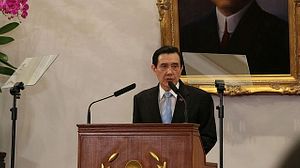The speech of Taiwanese President Ma Ying-Jeou on Taiping Island (also known as Itu Aba, among other names) on January 28 not only demonstrates his view on the territorial disputes in the South China Sea, but also reveals the dilemma that confronts his successor, President-elect Tsai Ing-wen.
With its occupation of some South China Sea islands after the end of the Second World War, and with the publication of the eleven-dash line on its map in 1947, the Republic of China (ROC) regime, despite losing its governance over Mainland China in 1949, has officially maintained substantial territorial claims over the South China Sea. However, the ROC’s isolated international status since the 1970s marginalizes its role in the region, given its inability to participate in related meetings and legal moves. Moreover, in order to maintain unofficial relations with regional countries and keep itself distinct from Beijing, Taipei has rarely highlighted its broader claims. In 2000, Taiwan’s garrison on Taiping was downgraded from the Marine Corps to the Coast Guard in a bid to lower tensions. Since 2008, however, in step with growing cross-strait integration, the Ma administration gradually ramped up its rhetoric on the South China Sea, among other things proposing that Taipei and Beijing organize a joint fleet to patrol the waters.
In his recent speech, Ma has gone a step further. The Taiwanese president used the Qing Empire’s naval presence in the 18th century and the ROC’s maps in 1935 and 1947 as evidence of the legitimacy of Chinese sovereign claim over the South China Sea, and insisted that Taiping was an island, rather than a rock or a reef as the Philippines argues in the international tribunal. With highly overlapping sovereign claims of both Taipei and Beijing in the South China Sea, listing historical evidence helps the latter’s sovereign claim, and the island status of Taiping would help the latter’s argument, given associated maritime rights and the exclusive economic zone. Although Ma also mentioned peaceful solutions and joint development, his attitude on the ROC’s sovereignty over the South China Sea is assertive. In fact, Ma had planned his visit to Taiping Island last November, but cancelled in the face of U.S. pressure. The American Institute in Taiwan, the de facto U.S. embassy, again expressed official concern about Ma’s January visit, but on this occasion to no avail.
By the standards of normal democracies, the visit was unusual: Lame duck presidents do not typically propose major policies or make such dramatic statements. However, with its unique statehood and clashing national identities, Taiwan is not a normal democracy. From this speech, his efforts to promote cross-strait integration in the past eight years, and his evident delight at meeting with Chinese President Xi Jinping last year, Ma’s Chinese identity is obvious. In the context of this identity, it is reasonable for him to bolster China’s claim, whether that be centered in Taipei or Beijing, over the South China Sea.
Despite only three months remaining in his presidency, Ma’s speech on Taiping could highlight the dilemma the South China Sea represents for Taiwan and its next government.
On the one hand, Taiwanese people with rising local or Taiwanese identity clearly demonstrated in the recent elections a desire to maintain their autonomy, and even pursue independence, from China. On the other hand, given official claims and the potential resources at stake, public opinion in Taiwan is in favor of maintaining control over Taiping and pursuing other sovereign claims in the South China Sea. That is tantamount to stronger links with China. For a leader with a strong Chinese identity, such as Ma, that may not be a problem, but it could be a challenge for Tsai, Ma’s successor.
If Tsai keeps her campaign promise of accepting the status quo, then Ma’s emphasis on sovereignty over the South China Sea will impede the new president’s policy of strengthening relations with Southeast Asian countries, particularly Vietnam and the Philippines. Tsai hopes to develop relations with Southeast Asia as a means of lowering Taiwan’s economic dependence on China, but territorial claims may well get in the way. Moreover, by taking a similar tone on the South China Sea, Taipei may be seen as Beijing’s “partner” or even “subordinate,” reducing the former’s autonomy and potentially placing it at odds with the United States and Japan.
In fact, Tsai has played down Taiwan’s sovereign claims over the South China Sea, but this leaves her vulnerable to attack from opposition parties and public opinion, given the strength of support in Taiwan for the sovereignty claims. Theoretically, the new president could seek to clarify the ROC’s legal status and its connection with China, the main basis for its South China Sea claims, but that risks the ire of Beijing and of those Taiwanese who support the claims.
With no easy solution, the new administration may adopt the age-old political tactic of strategic ambiguity, to avoid either negative outcome. The risk here, though, is that current tensions in the South China Sea have raised the risks of incidents occurring between China and other claimant states, which would spotlight the issue and force Taipei to confront the dilemma.
Taiwan’s contradictory attitude on the South China Sea reflects its abnormal statehood. As long as that abnormality persists, Taiwan will remain linked to China on the South China Sea and the dilemma will persist.
Wu Shang-su is a research fellow in the Military Studies Programme of the S. Rajaratnam School of International Studies (RSIS), Nanyang Technological University.

































